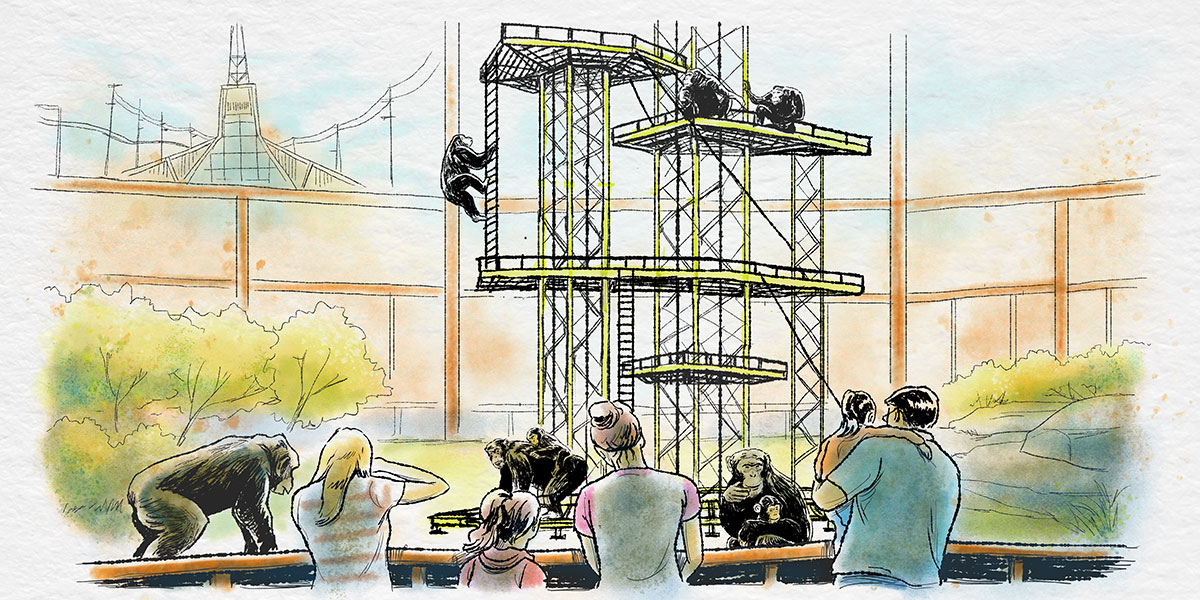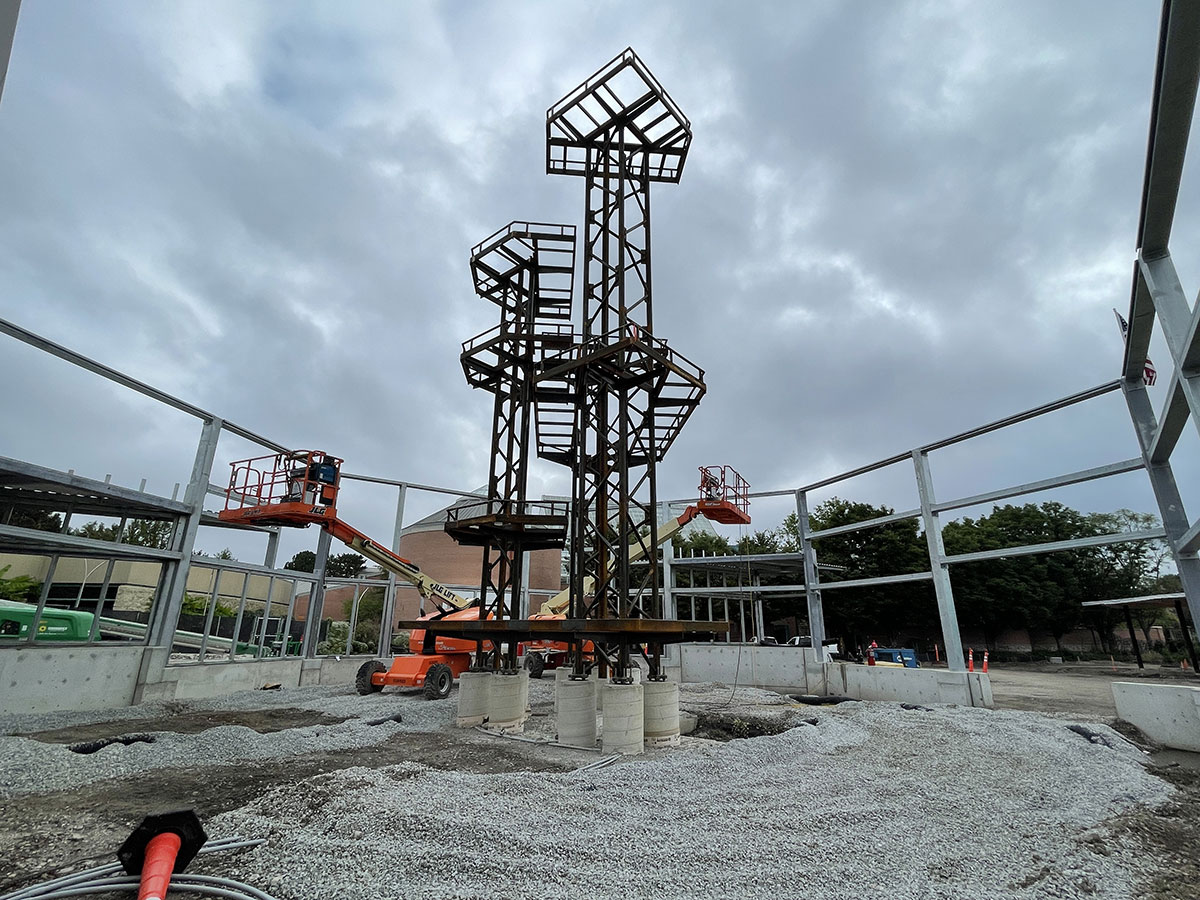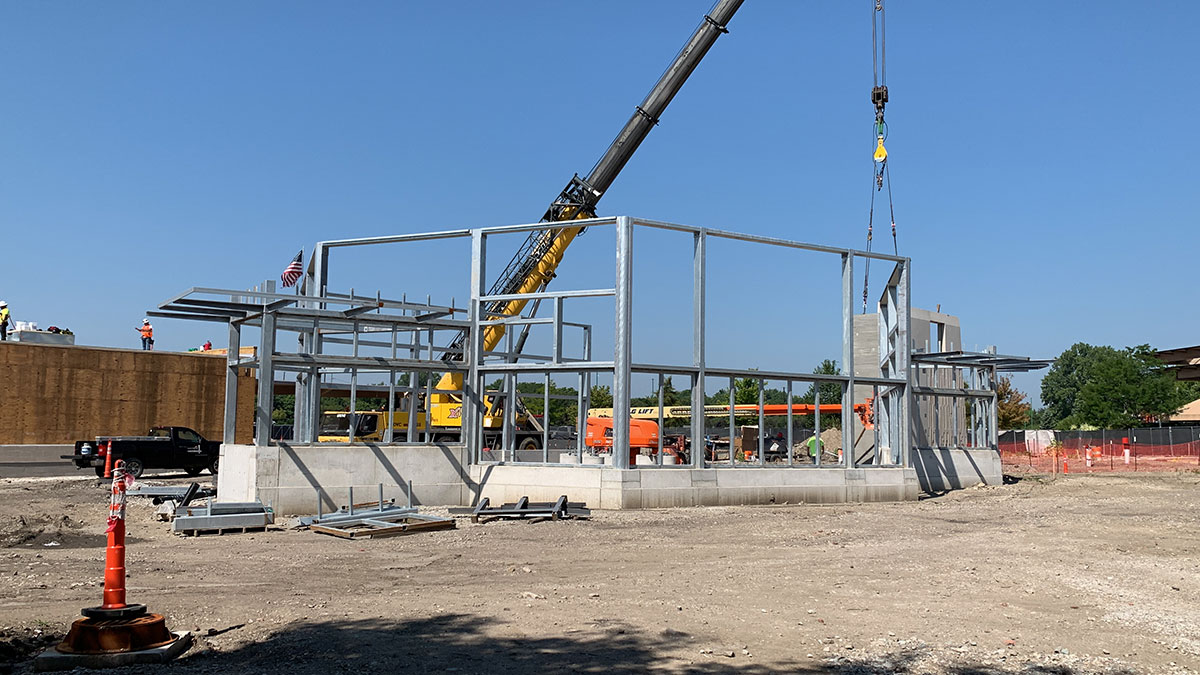Subscriber Benefit
As a subscriber you can listen to articles at work, in the car, or while you work out. Subscribe NowA chimpanzee exhibit spanning nearly two-thirds of the property. A research center focused on helping preserve endangered species populations. A new welcome center with animal “ambassadors.”
Those improvements and more are part of the vision Indianapolis Zoo officials were set to lay out Thursday night at the Indiana State Museum as they launch the public phase of a $53 million fundraising campaign that will run for the next two years.
Already, the zoo has raised 60%, or $31.8 million, of its goal, with gifts from several institutions, including the Lilly Endowment, which contributed $9 million. The Cohen Family Foundation, the Nina Mason Pulliam Charitable Trust and dozens of individual donors have also contributed.
“The community so far has responded with great enthusiasm and generosity, so we are nothing but optimistic as we move through this campaign,” Indianapolis Zoo CEO Rob Shumaker told IBJ this week, in advance of the announcement.
“What we’re doing with the projects associated with this capital campaign [affects all our visitors], in that they absolutely redefine the zoo and the experience here,” he said. “It is really transformational for us in terms of how [patrons] will experience a visit here.”

New spaces on the way
Each of the campaign’s projects are already under construction. Work began quietly in March, with some construction already visible to zoo visitors.
Called the “Campaign for Our Zoo,” the fundraising effort is the zoo’s largest in its 58-year history and will help fund several longstanding initiatives and new projects. Those include a revamped entrance and visitor intake area, along with the Global Center for Species Survival, which was first announced in 2019 as part of a partnership with the International Union for Conservation of Nature. That program launched in 2020 and has been operating from the zoo’s administrative building.
The $5 million welcome center will house ticketing, restrooms and other amenities, including special “animal ambassadors” like sloths, aardvarks, birds, snakes and juvenile alligators.
The zoo is designating $13 million for the species center, which includes $5 million to operate the center for five years. The center is where a team of local experts will collaborate with others across the globe on efforts that help limit disruption to habitats that could lead to further extinction of animals and plants.
“Our mission is very clear, in terms of our commitment to species diversity and global conservation. We were doing a very good job prior to launching this campaign. But we realized, given the state of the natural world and the pressures that are being exerted on species’ survival around the world, we needed to do more, and we wanted to do more,” Shumaker said.
“The timing of [this center] was in response to the threats to global biodiversity, which have only accelerated year after year. So, we really felt some urgency to move forward with projects in our brand-new department here focused entirely on global species conservation.”
The welcome center and species center are expected to open to the public on Memorial Day weekend 2023. Extensive improvements are also planned for the 27-acre site south of Washington Street that the zoo acquired in 2019 for a satellite parking lot through a deal with Ambrose Property Group. Because portions of the zoo’s expansion are eating into the existing parking, that satellite lot will see extensive use in the coming years, Shumaker said.
Then there’s the plans for the apes.

The International Chimpanzee Complex, a $25 million development that will open in 2024, is expected to be a new centerpiece for the zoo, with the exhibit being the first to greet the facility’s visitors after they walk through the welcome center. The 4,500-square-foot outdoor arena will be visible from almost any place on the zoo property with a tall, singular outdoor climbing structure.
The chimps will be able to access other areas of the zoo as well through an elevated path that stretches along the main walkways of the zoo—extending from a 3,100-square-foot space near the dolphin complex to the former athletic dog arena located south of the kangaroo exhibit.
The exhibit is expected to have as many as 30 adult chimpanzees and will mark the first time the apes have been incorporated into the zoo’s programming. Several chimps have already been welcomed into the zoo family, Shumaker said, as other zoos have requested to relocate some of their animals to Indianapolis.
“We want people to truly understand what it means to be a chimpanzee,” he said. “And out of that, inevitably, people will have greater respect and concern and admiration for these great apes. That will lead directly to a much greater concern for their conservation in the wild. That’s a very valuable lesson we learned from previous work here at the zoo, particularly with orangutans. We’ve applied all those good lessons toward design for chimpanzees.”

A big impact
The Indianapolis Zoo is a major employer and hot spot for tourism activity in the city. It employs 700 people and welcomed 1.2 million visitors last year.
According to a study completed in late 2019 by Canopy Strategic Partners, the attraction is expected to generate an economic impact of $535 million from 2021 to 2029—averaging $59.5 million per year. About 63% of visitors come to the zoo from outside Indianapolis, and more than 20% come from outside Indiana.
Those numbers are no surprise to Chris Gahl, executive vice president of Visit Indy, who said the continued investment in the zoo is good for the community’s tourism efforts. But he said the zoo’s continued focus on conservation efforts shines a light on Indianapolis’ role in the global preservation of species.
That awareness already has been accomplished in part by the Indianapolis Prize, a biennial honor that recognizes individuals entrenched in animal conservation efforts in their respective fields. The award is considered among the most prestigious of its kind in the world.
“Building upon [the prize], you can see how the zoo has continued to transform itself into a physical space that prioritizes conservation and education, with tourism-related attractions that underpin education and continue to attract visitors nationwide,” Gahl said. “This is a growing request from visitors to continue to learn and have meaningful experiences within their visits, so the zoo’s work from our perspective has been very deliberate and very meaningful. You can see how much care and attention they pay to the conservation and the educational piece in the physical space that’s now growing once more.”
Since 1999, the Indianapolis Zoo has raised more than $71 million as part of three fundraising campaigns—not including the current effort.
The first, a $10 million campaign that started in 1999, resulted in the African elephant preserve as well as new exhibits for snakes and jelly fish.
The first phase of the Campaign for Conservation and Community—which led to creation of the Indianapolis Prize, the Oceans exhibit and the dolphin pavilion—raised $31.1 million from 2003 to 2006. The second phase of that campaign—which ran from 2011 to 2014—raised $30 million that funded the orangutan exhibit, entrance renovations and the tigers and lions exhibits.
And since its last campaign, the zoo has spent nearly $20 million on nine new spaces, including the Bicentennial Pavilion near the park’s entrance ($10 million) in 2017, the elephant camp ($1.27 million) in 2020, and most recently, Kangaroo Crossing ($2.2 million) in 2022.
But Shumaker said it was time for a larger campaign.
“It’s been nearly 10 years since we’ve opened something truly transformational here at the zoo,” he said. “Everything that we knew from our assessment of this campaign, was that our timing is right in terms of support for the campaign. We were very thoughtful, very considerate and very measured in terms of the timing of this launch and moving forward.”
Story continues after the graphic.
Donors tout zoo’s value
Among the individual donors to the Zoo’s campaign is Jim Irsay, owner of the Indianapolis Colts. Irsay on Nov. 21 announced plans to give $1 million to the zoo for its new entry area, which will be called the Indianapolis Colts Welcome Center Plaza. The gift is among the largest single donations from individuals for the zoo’s campaign so far.
“The Indianapolis Zoo is a world leader in wildlife and natural conservation and oversees efforts and projects that are truly making a difference across the globe,” Irsay said in written remarks at the time. “Not only is the zoo making great strides to preserve nature around the world, but it also provides world-class educational and entertainment opportunities for the entire Indianapolis community and makes our city an even better place to call home.”
Tech entrepreneur Scott Dorsey and his wife, Erin, contributed an undisclosed amount. The couple and their Dorsey Foundation have supported past campaigns as well, including efforts to build the orangutan exhibit and support the Indianapolis Prize.
“This campaign solidifies the Indianapolis Zoo’s position as a conservation leader,” Erin Dorsey, who runs the couple’s foundation and serves on the zoo’s fundraising committee. “The Indianapolis Zoo connects science and scientists with the public through its internationally recognized exhibits and programming, and especially through the Indianapolis Prize.
Elaine Bedel donated an undisclosed amount alongside her husband, Eric.
She said the donation came after she was approached during what’s considered the silent phase of the zoo’s fundraising campaign. Silent phases are conducted in hopes of generating a large portion of financial support and momentum ahead of a campaign going public.
Bedel said while she has an appreciation for the zoo’s impact on tourism—she is CEO of the Indiana Destination Development Corp.—her focus is on conservation. Bedel and her family have supported past zoo campaigns, as well as the Indianapolis Prize.
“We chose the zoo for a focus of our funding because we think it’s an important institution,” Bedel said. “When you think about what has happened to many of the species that were here long before we were—and now they’re gone—it’s important to do the necessary research to keep that from continuing to happen and save those that are in jeopardy. The zoo is … a statewide asset from that perspective.”•
Please enable JavaScript to view this content.

Wonderful news!
yes